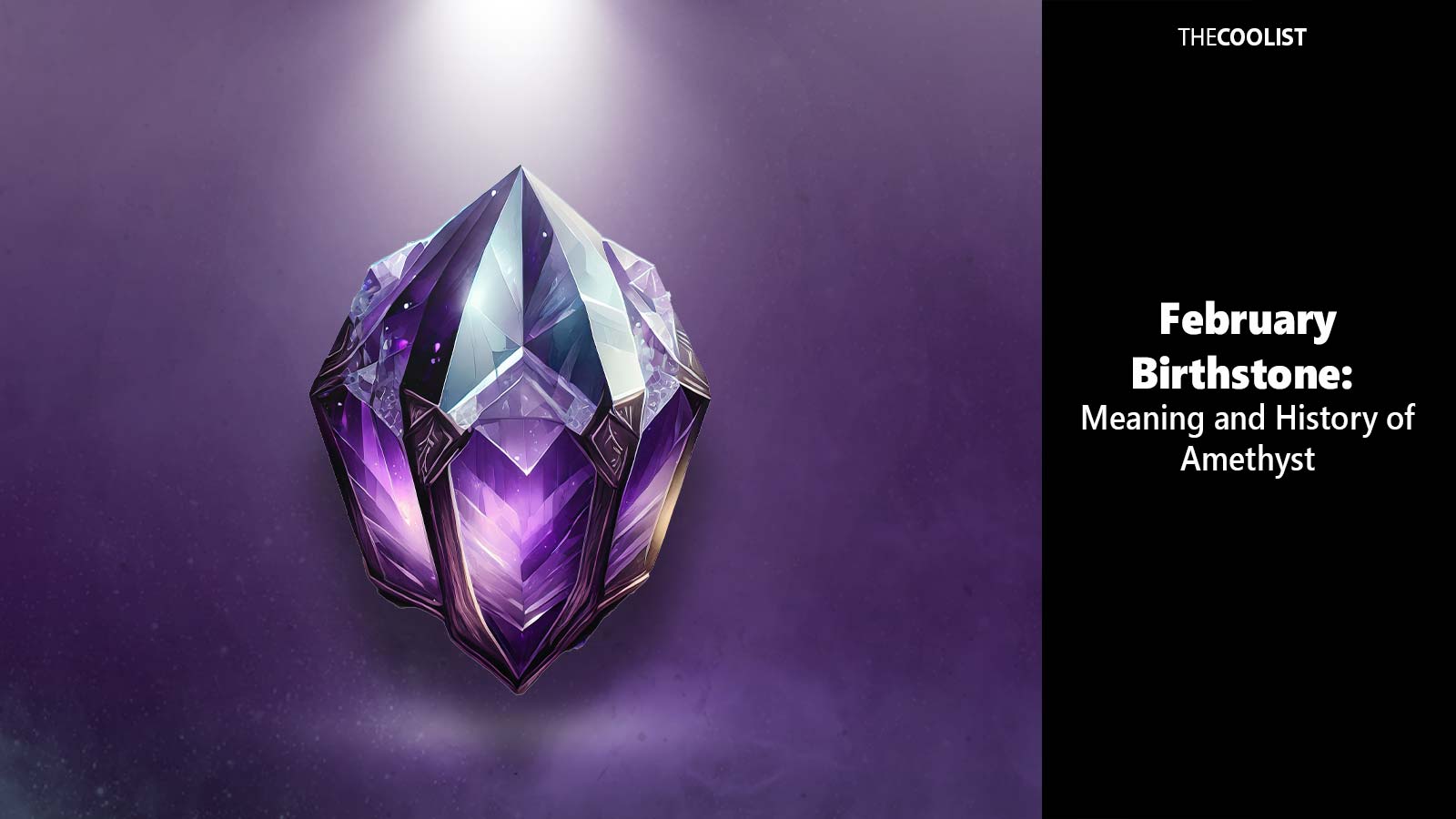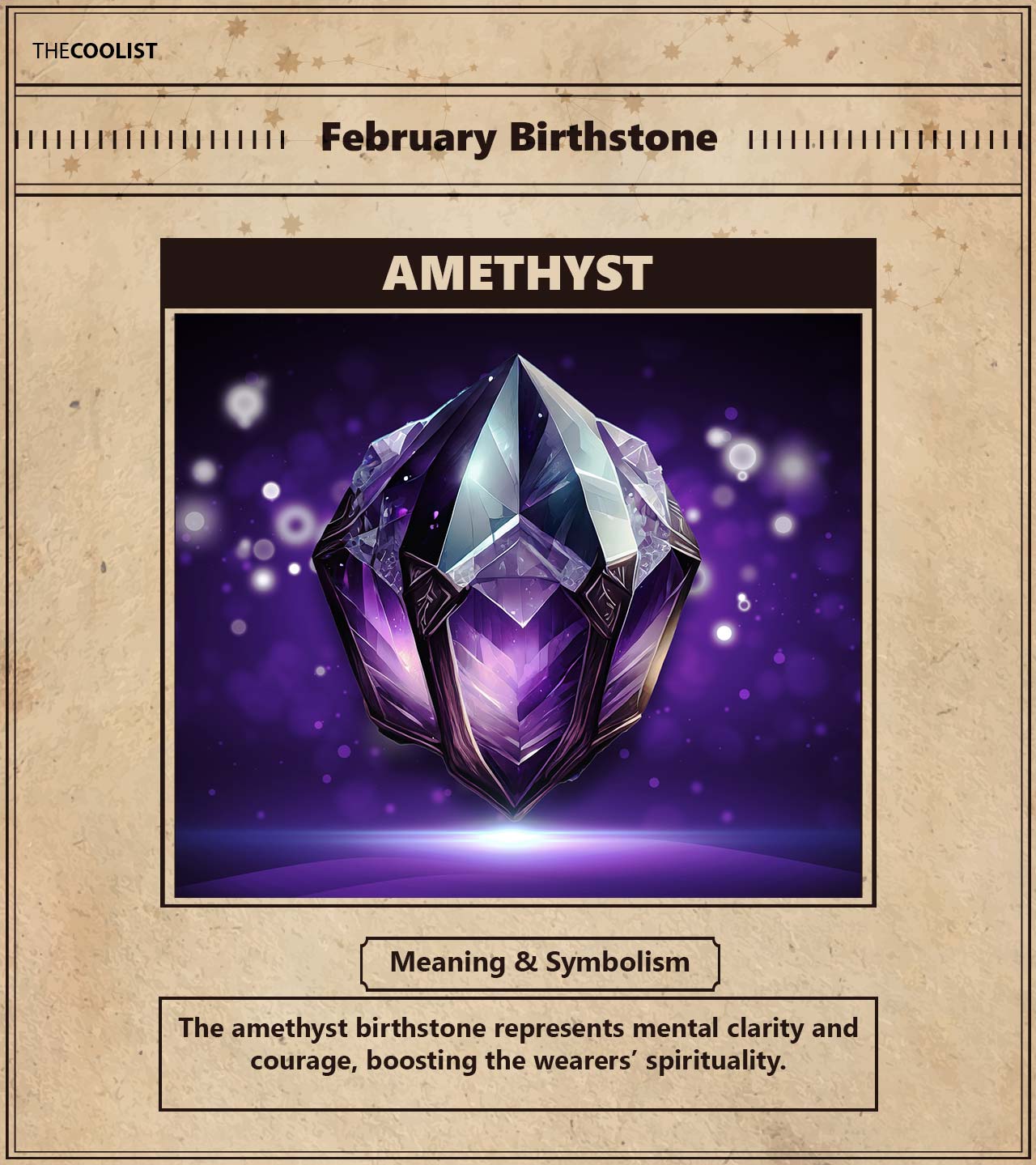The February birthstone is the amethyst gemstone and symbolizes sincerity, clarity, and tranquility. February’s birthstone is known for its purple hues that range from pale lavender to deep violet. Amethyst provides people born in February with more than accessories or trinkets and possesses historical importance and metaphysical significance.

The amethyst birthstone symbolizes sobriety and clarity of mind, encouraging a spiritual intervention. For example, the word “amethyst” is a derivative of the Greek word “amethystos,” which means “not drunken.” Ancient Greeks believed that wearing amethyst or using amethyst cups would prevent intoxication and promote clear thinking. The February birthstone is prized for promoting mental well-being and peace. For example, owners of amethyst amulets in the Middle Ages believed they could detect poison and that wearing the stone would reduce their anxieties regarding any personal attack.
February’s amethyst birthstone remains a popular gemstone for accessories and metaphysical practices. However, despite the Jewelers of America declaring amethyst the official birthstone for February, the second month of the year boasts multiple unofficial alternatives. For example, aquamarine represents the Pisces zodiac sign, which includes part of February. Having multiple stones to choose from gives people born in February a chance to mix and match their birthstones for more style options or energy combinations.
Below, we explore the nuances of the February birthstone and learn about its meaning, history, and benefits.
What does the February birthstone mean?
The February birthstone amethyst symbolizes sincerity, clarity, and tranquility. Firstly, February’s birthstone represents sincerity and sanctity. For example, an early reference to birthstones by month in a poem published in 1870 by Tiffany & Co. tells people born in February to use amethyst to show their sincerity.
Secondly, the February amethyst birthstone symbolizes clarity. Amethyst traces back to ancient Greece, where the gemstone diminished the consequences of excessive alcohol consumption. The word “amethyst” is derived from the Greek word “amethystos,” which means “not drunken.” For example, Clifford Lindsey Alderman describes the origin of amethyst symbolism in his book Symbols of Magic: Amulets and Talismans. Alderman states that the ancient Greeks believed wearing amethyst would prevent intoxication and promote clear thinking.
The final February birthstone meaning is tranquility. Amethyst is associated with peace and tranquillity, helping to calm emotions, reduce stress, and promote relaxation. Its soothing energy is often used for emotional healing and inner peace.
Mystical beliefs surrounding amethyst describe it as a symbol of spiritual protection. Amethyst is esteemed in spiritual and meditative practices for its ability to elevate awareness and foster a connection with higher states of consciousness, stimulating key chakras to enhance spiritual growth. It is a guardian stone to shield its wearer from negative energies and psychic disturbances. This dual capacity for enlightenment and protection makes amethyst a powerful ally for those seeking emotional and spiritual balance.

What is the difference between modern and traditional February birthstones?
The main difference between modern and traditional February birthstones is the number of stones between them. The traditional February birthstones encompassed a trio of gems, including amethyst, hyacinth, and pearl. However, the modern February birthstone list has been streamlined to align with the 1912 Jewelers of America standardization, which recognizes amethyst as the singular gemstone for the month, celebrated for its singular charm and historical significance.
Does February have more than one birthstone?
Yes, February has three alternative birthstone options: pearl, bloodstone, and jasper. The first alternative birthstone for February is the pearl, a traditional option coming back in style. A pearl is an organic gemstone formed within the shells of oysters and mussels known for its lustrous and iridescent exterior, representing purity and elegance. Monthly birthstone options, such as the Tibetan zodiac and guardian angel stones, have expanded to incorporate more cultures.
The second alternative is bloodstone, which corresponds to the Tibetan zodiac. Bloodstone is a dark green variety of chalcedony with red and brown spots resembling blood drops. It contains protective and healing properties and has been used for centuries in jewelry and amulets. The third option for February is the guardian angel stone jasper, an opaque chalcedony with a smooth surface and multi-colored striped, spotted, or flamed patterns. It’s revered for its grounding properties and has been utilized throughout history in jewelry, ornaments, and talismans.
Is there a February zodiac birthstone?
Yes, two February zodiac birthstones correlate to the Aquarius and Pisces zodiac signs. The first February zodiac birthstone is the Aquarian amethyst. The Aquarius zodiac birthstone is the core stone for February and supports intellect and spirituality. Amethyst enhances Aquarius’ natural inclination toward exploring higher realms of thought and intuition.
The second gemstone for the February zodiac is Pisces’ aquamarine. Aquamarine resonates with Pisces’s compassionate, intuitive, and artistic spirit, offering clarity of mind. People born in February may choose between amethyst and aquamarine gems to enrich their daily lives. The amethyst birthstone nurtures spiritual awareness and intellectual insight for the progressive and humanitarian Aquarius. Meanwhile, Pisceans will discover that the aquamarine birthstone bolsters their creativity and soothes their sensitive nature.
What color is February’s birthstone?
The color of February’s birthstone is a deep purple. The color purple embodies the characteristics of nobility, calmness, and sobriety, resonating with the amethyst birthstone’s symbolism. Amethyst’s shade of purple varies from pale lavender to deep violet as advances in gemology have expanded the color palette through the years. For example, variants such as the pale Rosa de France amethyst or the deep Siberian amethyst offer a unique energy profile. Incorporating a range of these purple shades into one’s life is recommended to embrace the amethyst birthstones’ benefits thoroughly.
What is the February birthstone crystal shape?
The February birthstone occurs in a variety of natural and lab-grown shapes. Below is a list of the different February birthstone crystal shapes.
- Prismatic crystals: Prismatic crystals are elongated, six-sided crystals with pointed ends that form in a columnar habit.
- Geode formation: Geode formation amethyst is formed in rock cavities with crystals ranging from small, stubby crystals to large, well-formed points.
- Scepter crystals: Scepter crystals grow over a pre-existing base to form a stem-like structure topped with a larger crystal resembling a scepter.
- Druzy formation: Druzy amethyst showcases tiny crystals covering a matrix’s surface, creating a sparkling, textured appearance.
Amethyst features a hexagonally cross-sectioned crystalline structure. The hexagonal arrangement allows the development of its characteristic six-sided prismatic crystals, each varying subtly in hue and intensity, resulting in a spectrum of purple shades. Such diversity in form and coloration offers those born in February various choices to symbolize their birth month.
What’s the history of the February birthstone?
The history of the February birthstone is traced back to ancient Greece and Rome, where it was used in jewelry and drinking vessels. Oliver C. Farrington’s book Gems and Gem Minerals describes the ancient Greek belief that amethyst protects against alcohol poisoning and intoxication. The belief stems from Greek and Roman mythology, amethyst is tied to Bacchus, or Dionysus, the god of wine. Symbols of Magic: Amulets and Talismans by Clifford Lindsey recounts the story of Amethyst, a beautiful nymph turned into a gemstone by the goddess Diana to protect her from Bacchus’s advances. The remorseful Bacchus poured wine over the stone, staining it in a deep purple hue.
Conversely, the amethyst crystal is associated with Saint Valentine, a Roman Catholic saint. Saint Valentine is said to have worn an amethyst ring inscribed with a cupid symbol to represent love and marriage. This association aligns amethyst with a tradition of giving one’s spouse amethyst on their anniversary to sanctify their marriage.
February’s amethyst birthstone experienced a cultural shift from a protective symbol to one of nobility and is a common choice for royal accessories. For example, King Charles II’s Sovereign’s Scepter with Cross used for his coronation features a faceted amethyst monde. Moreover, Catherine the Great, empress of Russia, adorned herself in amethyst necklaces, earrings, and other ornaments.
Gemmologists from the Jewelers of America solidified a finite list of modern birthstones in 1912. The list decided that amethyst was most appropriate to represent the energies and personality of February. The official list allows consumers to easily find and match their gem to their birth month. Having a standard modern birthstone for February provides clarity and aligns the stone with historical and metaphysical purposes. For example, amethyst maintains a connection to its symbolism. It is used as a protective talisman for meditation and given as a gift to loved ones.
Where is the February birthstone found?
The February birthstone, amethyst, is found worldwide, with the most significant sources coming from South America, Africa, and Russia. Amethyst production is prevalent throughout South America, with Brazil being one of the largest producers in the world. The state of Minas Gerais is known for its high-quality amethyst deposits displaying rich purple hues widely used in jewelry. Farther down the coast, Uruguay is renowned for its deep violet and highly transparent amethyst crystals. The country’s Artigas region is famous for producing some of the world’s finest amethyst specimens.
Secondly, Africa is home to amethyst mines producing a variety of high-quality gems. Zambia is an amethyst source known for its medium to dark purple stones, appreciated for their color saturation and clarity. Off Africa’s western coast, Madagascar mines yield pale and intense purple gemstones known for their transparency and color variations. Finally, amethyst is found in from the Urals to the Siberian coast. Russian Amethyst exhibits a range of colors, from pale lavender to deep purple.
February birthstone chart
Below is a chart detailing the core aspects of February birthstones.
| February birthstones | |
| Modern | Amethyst |
| Traditional | Amethyst, hyacinth, and pearl |
| Zodiac | Amethyst (Aquarius) and Aquamarine (Pisces) |
| Meaning | Sincerity, clarity, and tranquility |
| Color | Deep purple |
| Historical significance | Used to prevent intoxication |
What are the February birthstone personality traits?
There are five personality traits associated with the February birthstone. Below is a list of the common traits associated with amethyst.
- Intuition: Amethyst gemstones enhance intuition. Similarly, individuals born in February have a strong sense of intuition and a deep understanding of their inner selves.
- Peacefulness: Amethyst’s association with peace and tranquillity aligns with February-born individuals’ calm and peaceful demeanor.
- Protection: Amethyst is considered a protective stone, much like the nurturing and protective nature of those born in February.
- Creativity: Amethyst’s energy boosts creativity and imagination. People born in February are creative thinkers who enjoy exploring new ideas and artistic pursuits.
- Emotional balance: Amethyst’s soothing energy correlates to February individual’s uncanny ability to remain calm in highly stressful situations. The second month of the year’s numerological connections doubles the harmonious aspects of the amethyst stone.
Are there benefits to wearing a February birthstone?
Yes, a February birthstone benefits the wearer by inspiring spiritual growth, creativity, recovery, and well-being. The first benefit of wearing amethyst is that it sharpens your instincts and grounds you in your body. Amethyst is highly regarded for its spiritual properties, and the emphasis on spirituality reminds you to focus on growth and progression. The second benefit of wearing amethyst is boosting creativity and stimulating imagination. Amethyst is associated with creative expression, and wearing it will inspire innovation and artistic endeavors.
The third benefit of the February birthstone is recovery. Amethyst’s historical association with sobriety has transformed it into a talisman for helping to alleviate addictive behaviors and encourage sobriety. However, it is not a substitute for professional help. The fourth benefit of wearing amethyst is to promote well-being. Crystal enthusiasts view amethysts as a tool to promote vitality and use it alongside meditation and breathwork to aid circulation.
What are the different ways you can wear a February birthstone?
You can wear a February birthstone as a ring, necklace, earrings, or cufflinks. The first common way to wear the February amethyst is as rings because they come in various styles. The varying styles produce intricate designs such as classic solitaire rings. The second way to wear a February birthstone is as a necklace or pendant. Wearing an amethyst necklace means the stone is close to the heart and more likely to activate the heart chakra. Amethyst necklaces come in various designs, including simple pendants, statement necklaces, and those with amethyst accents.
The third way to wear an amethyst birthstone is as earrings. Jewelers sell studs, dangle earrings, or hoops adorned with amethyst gemstones. The final example of different ways to wear amethyst is to buy them as a pair of cufflinks. This is a popular choice for men who want to add an elegant touch to their business suit or formal attire.
| Further reading on birthstones | |||||||||||
| January | March | April | May | June | July | August | September | October | November | December | |

